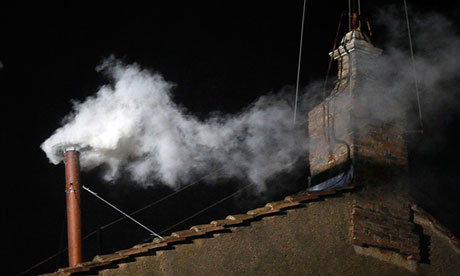
The Roman Catholic church has a new pope. White smoke flowed from the chimney above the Sistine Chapel in the Vatican shortly after 6pm on Wednesday, signalling that one of the candidates for the pontificate had obtained the necessary two-thirds majority for election.
As is customary, the identity of the new pope was not immediately made known. And the crowd in St Peter's Square was waiting expectantly for him to appear on the huge balcony that runs across the front of St Peter's basilica.
The fumata bianca – the white smoke signal that marks the successful conclusion of a papal conclave – arrived after five ballots on the second day of voting. The smoke that poured out of the comignolo, the copper and steel chimney on the roof of the Sistine Chapel, was greeted with cries of delight and applause from the crowd below.
Soon afterwards, the bells of St Peter's rang out, confirming that a new pope had taken over the spiritual leadership of the world's 1.2 billion baptised Catholics.
Inside the Sistine Chapel, after the final vote was cast, the most junior of the cardinals, James Harvey, a former prefect of the papal household, called in the secretary of the college of cardinals, Monsignor Lorenzo Baldisseri, and the master of papal liturgical ceremonies, Monsignor Guido Marini, to witness the new pope's acceptance of one of the most daunting jobs on earth. The most senior of the electors, Cardinal Giovanni Battista Re, approached the pope-to-be and – in accordance with time-honoured tradition – asked him, in Latin: "Do you accept your canonical election as supreme pontiff?"
Having obtained his consent, he will have asked him: "By what name do you wish to be called?" The master of ceremonies, acting as a notary, will then have summoned two of his staff to act as witnesses, and prepared the document that certifies the new pope's acceptance.
Newly elected popes are taken to be robed in the so-called Room of Tears, its name an indication of the reluctance with which most approach the task for which they have been chosen. The last holder of the office, Benedict XVI, introduced a change into the ritual that allows for the new pope to pray before he is announced to the world.
Benedict abdicated on 28 February, saying that he was no longer able to cope with the burden of his office. He was the first pontiff to resign voluntarily since Celestine V in 1294.
The world's Catholics will be looking to his successor to provide not only spiritual inspiration but also firm leadership. The new pope was chosen against a background of turbulence and strife unprecedented in modern times. He takes on the leadership of a church whose faithful have been shocked by a proliferation of clerical sex abuse scandals throughout the rich world and dismayed by events in and around the Vatican.
The day for the 115 cardinal-electors began at about 6.30am local time in the Casa Santa Marta, their simple but comfortable – and highly protected – residence in the walled city state. After breakfast, they made their way to the Apostolic Palace, the home of the popes, for morning mass in the Pauline Chapel. By about 9.30am, they had settled themselves into the Sistine Chapel for prayers and the resumption of voting.
Benedict's startling decision to resign came after years of mounting tension and discreet but venomous infighting in the Roman Curia, the central administration of the Catholic church. Last year, some of the pope's correspondence, pointing to bitter rivalries and maladministration – or worse – in the Vatican was published in book form.
Benedict's butler, Paolo Gabriele, was tried and imprisoned for leaking the documents, but the journalist to whom the papers were passed has said that his source was part of a much broader network of disaffected Vatican employees and officials. Gabriele's arrest coincided with a renewed controversy over the Vatican bank, whose chairman was summarily dismissed last May.
The scandals – and a string of controversies over the pope's own declarations – distracted attention from what was expected to be the central theme of his papacy. Benedict came to the leadership of the Catholic church as the pope who would begin the process of re-evangelising an increasingly secular western world.
That too will be an important challenge for his successor. In the approach to the conclave several cardinals said they wanted a great pastor for the world's biggest Christian denomination.
No indication of how or why the new pope was chosen was expected to emerge. On Tuesday, before the start of the conclave, the cardinal-electors took an oath of secrecy, as had those Vatican employees and officials involved in the election.
Additional precautions included a sweep of the Sistine Chapel to ensure that no listening devices had been planted inside and the use of electronic jamming techniques.

No comments:
Post a Comment